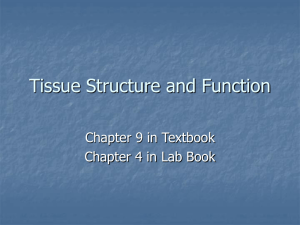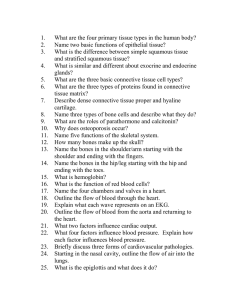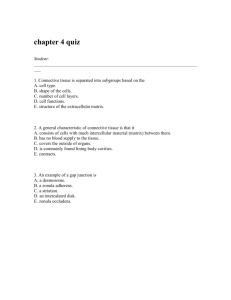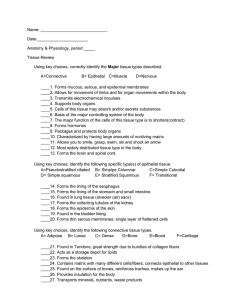File - Science with Shust
advertisement
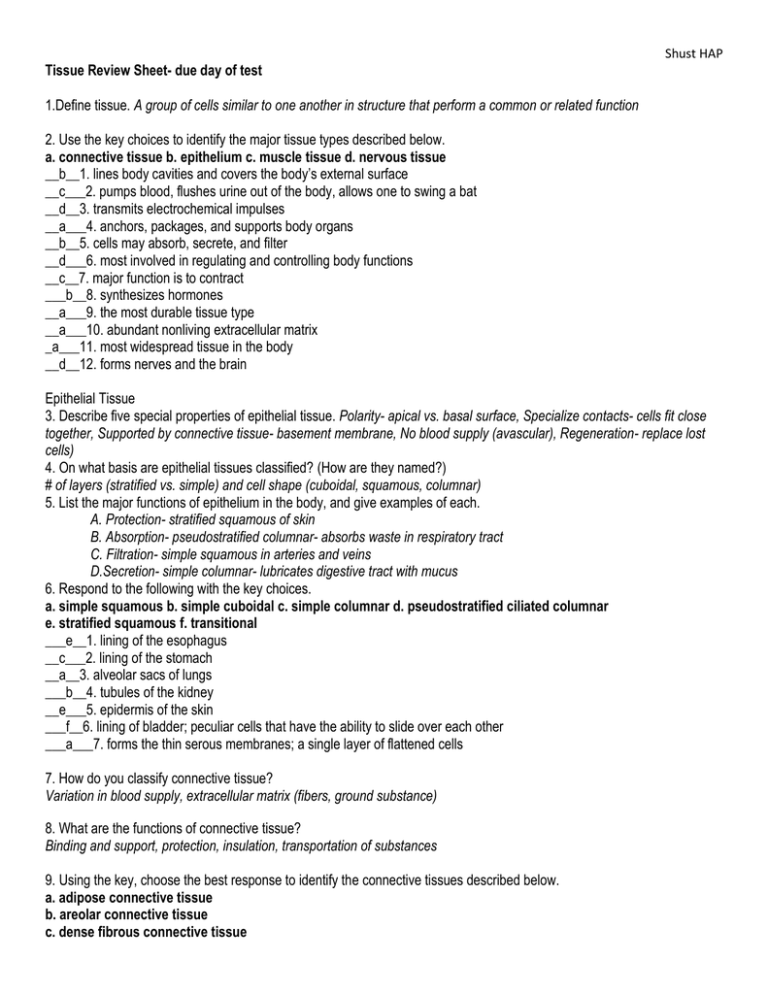
Shust HAP Tissue Review Sheet- due day of test 1.Define tissue. A group of cells similar to one another in structure that perform a common or related function 2. Use the key choices to identify the major tissue types described below. a. connective tissue b. epithelium c. muscle tissue d. nervous tissue __b__1. lines body cavities and covers the body’s external surface __c___2. pumps blood, flushes urine out of the body, allows one to swing a bat __d__3. transmits electrochemical impulses __a___4. anchors, packages, and supports body organs __b__5. cells may absorb, secrete, and filter __d___6. most involved in regulating and controlling body functions __c__7. major function is to contract ___b__8. synthesizes hormones __a___9. the most durable tissue type __a___10. abundant nonliving extracellular matrix _a___11. most widespread tissue in the body __d__12. forms nerves and the brain Epithelial Tissue 3. Describe five special properties of epithelial tissue. Polarity- apical vs. basal surface, Specialize contacts- cells fit close together, Supported by connective tissue- basement membrane, No blood supply (avascular), Regeneration- replace lost cells) 4. On what basis are epithelial tissues classified? (How are they named?) # of layers (stratified vs. simple) and cell shape (cuboidal, squamous, columnar) 5. List the major functions of epithelium in the body, and give examples of each. A. Protection- stratified squamous of skin B. Absorption- pseudostratified columnar- absorbs waste in respiratory tract C. Filtration- simple squamous in arteries and veins D.Secretion- simple columnar- lubricates digestive tract with mucus 6. Respond to the following with the key choices. a. simple squamous b. simple cuboidal c. simple columnar d. pseudostratified ciliated columnar e. stratified squamous f. transitional ___e__1. lining of the esophagus __c___2. lining of the stomach __a__3. alveolar sacs of lungs ___b__4. tubules of the kidney __e___5. epidermis of the skin ___f__6. lining of bladder; peculiar cells that have the ability to slide over each other ___a___7. forms the thin serous membranes; a single layer of flattened cells 7. How do you classify connective tissue? Variation in blood supply, extracellular matrix (fibers, ground substance) 8. What are the functions of connective tissue? Binding and support, protection, insulation, transportation of substances 9. Using the key, choose the best response to identify the connective tissues described below. a. adipose connective tissue b. areolar connective tissue c. dense fibrous connective tissue Shust HAP d. elastic cartilage e. fibrocartilage f. hyaline cartilage g. osseous tissue (bone) _c___1. attaches bones to bones and muscles to bones (tendons/ligaments) __a__2. acts as a storage depot for fat __c___3. the dermis of the skin __d,e,f__4. makes up the intervertebral discs __g__5. forms the hip bone _b___6. composes basement membranes; a soft packaging tissue with a jellylike matrix ___d,e,f__7. forms the larynx, the costal cartilages of the ribs, and the embryonic skeleton _d,e,f___8. provides a flexible framework for the external ear _d,e,f__9. firm, structurally amorphous matrix heavily invaded with fibers; appears glassy and smooth ___g__10. matrix hard owing to calcium salts; provides levers for muscles to act on __a__11. insulates against heat loss 10. What is the function of nervous tissue? Where is it located? What kind of cells can you find in nervous tissue? _Regulates and controls body functions by sending electrical impulses. Located throughout the body (brain, spinal cord, nerves). Can find neurons in nervous tissue 11. Check the appropriate spaces in the chart to indicate which muscle types exhibit each characteristic Characteristic Voluntarily Controlled Involuntarily Controlled Has striations Has a single nucleus per cell Has multiple nuclei per cell Attached to bones Found in walls of organs Has intercalcated discs Concerned with locomotion Changes internal volume of organ as it contracts Tissue of heart Skeletal Muscle X X Smooth Muscle Cardiac Muscle X X X X X X X X X X X X X 12. Write the 3 steps of tissue repair and describe them 1. Inflammation- WBCs and clotting proteins seep into injury- scab crated to prevent loss of blood 2. Granulation- new capillaries are formed, connective tissue makes collagen fibers, epithelial tissue is formed 3. Surface epithelium regenerates- epithelium thickens, fibrous tissue matures into scar tissue

